The reason for the serrated edges on some silver Roman Republic denarii is not known
By Numismatic Guaranty Corporation (NGC) ……
The edges of most silver denarii of the Roman Republic have no particular features beyond those imparted by the flow of metal during the striking process. There is, however, a group of coins known as serrati – denarii with ‘serrated’ edges – that is most unusual.
Comprising about two dozen issues, these coins were struck on planchets (blanks) with edges serrated with cuts of a blade. Exactly how these cuts were applied is not known, though it is clear that the serration occurred before striking. The cuts endowed these coins with the appearance of a gear with many teeth.
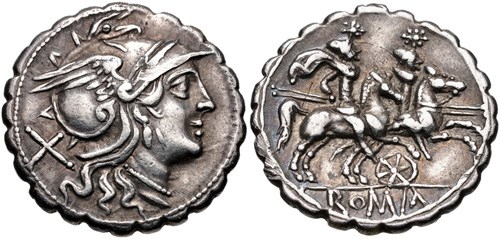
The first serratus appears to have been struck in 209 or 208 BCE, during the Second Punic War (218-201 BCE). Scholars believe it was produced at a mint on Sicily, which the Romans had recently recovered from the Carthaginian invader Hannibal. An example is shown above.
The motivation behind the edge serration is not known, and scholars have devoted a great deal of thought to the matter. Some believe it was an anti-counterfeiting device intending to expose the interior of the coin at its edge, thus reducing the likelihood of plated forgeries.
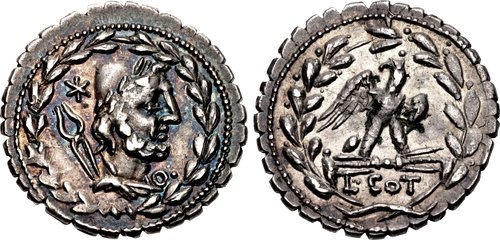
If that was the goal, however, it was only moderately effective. Ancient plated forgeries of serrati are known. In fact, one purporting to be a legitimate serratus of the moneyer L. Aureius Cotta, c.105 BCE, is shown above. Telltale breaks in the silver plating are visible at the edges of the eagle’s body.
Others suggest serrations indicated coins had special functions, or that they made them more appealing to some of Rome’s trading partners. Some also believe they helped prevent planchets from cracking when the coins were struck. Still others believe the serration was merely a decorative feature.
Even if the reason or reasons for the periodic creation of denarii serrati is unknown, one thing is certain: making the serrations was labor-intensive and must have been considered a worthwhile undertaking.
As we saw with the issue of 209/8 BCE described earlier, serration occurred early in the denarius series. However, after that solitary, first issue, more than half a century expired before another was produced. That second issue was struck in about 154 BCE for the moneyer C. Thalna.

The interesting thing about C. Thalna’s denarii is that nearly all surviving examples are struck on planchets without serrated edges (a non-serrated example is illustrated above). Serrated examples are very rare, and there is no good explanation as to why both versions were produced.
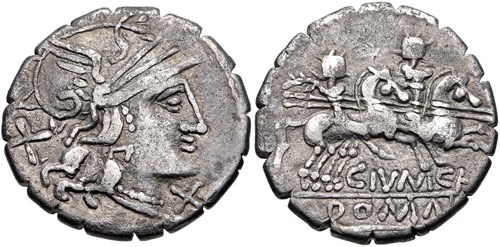
Unofficial imitations of Roman denarii were created throughout the provinces and bordering territories of the Roman world. Shown above is an imitative denarius based upon the types of the moneyer C. Junius (c.149 BCE). We illustrate this piece because C. Junius’ official coinage is not serrated, yet this ancient imitation from eastern Europe is serrated, showing how popular denarii serrati were among Rome’s trading partners in the region.
After these first two issues, all remaining serrati were struck between c.118 and c.59 BCE. What follows is a nearly complete gallery of the serrati from that period (as well as some related material).

Above is a serratus of c.118 BCE issued for the moneyer M. Aurelius Scaurus, seemingly at the mint of Narbo in Gaul. It shows the helmeted head of Roma and a biga (a two-horse chariot) driven by a Gallic warrior holding a spear, a carnyx (an ancient bronze horn or trumpet), and a shield.
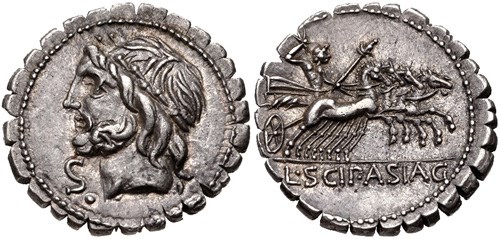
A serratus of the moneyer L. Scipio Asiagenus, struck c.106 BCE, appears above. It pairs the head of the supreme god Jupiter with that same god driving a quadriga (a four-horse chariot).
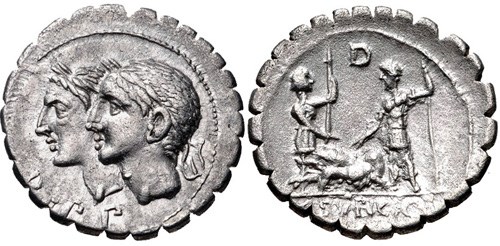
Struck contemporarily with the previous coin, in c.106 BCE, is the serratus of C. Sulpicius C.f. Galba shown above. It features the heads of the Dei Penates and two men pointing at sow in an oath-taking scene.
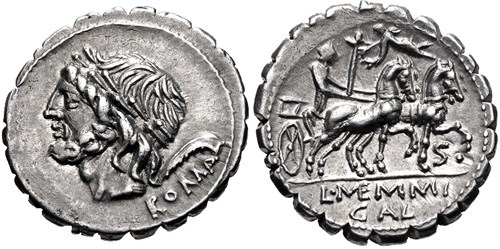
A third serratus from c.106 BCE is an issue of the moneyer L. Memmius Galeria, shown above. It features a portrait of the god Saturn and shows the goddess Venus driving a biga, with Cupid hovering above.
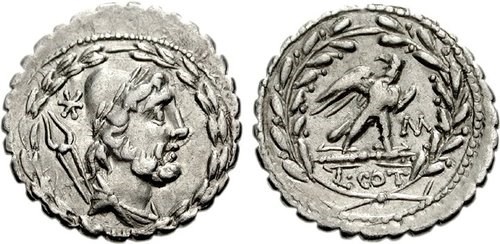
Just one year later, in c.105 BCE, the serratus shown above was issued by the moneyer L. Aurelius Cotta. It shows the bust of the god Vulcan and a laurel wreath enclosing an eagle upon a thunderbolt. Earlier in this article, a plated counterfeit of this type was shown.

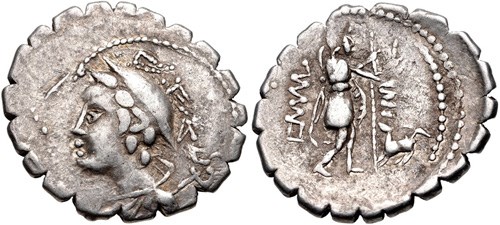
Fast-forwarding to c.82 BCE we find the serratus above, issued at the Rome mint for the moneyer C. Mamilius Limetanus. It features the bust of the god Mercury and a scene of the Greek hero Ulysses greeted by his dog Argus. Shown beneath that is an imitative denarius which copies not only the original design but also the edge serrations.

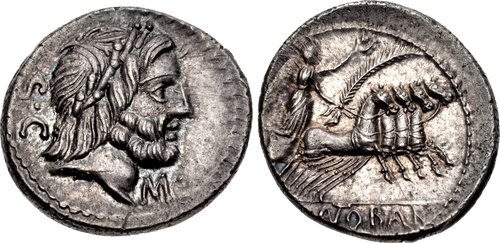
Above is an interesting pair of denarii. First is a standard example of the coinage of the moneyer Q. Antonius Balbus, c.83-82 BCE, which was intended to be serrated. It shows the head of Jupiter and Victory driving a quadriga. Beneath that is an extremely rare coin without edge serration – presumably an error piece.

In the next year, c.81 BCE, this serratus of the moneyer L. Volteius L.f. Strabo (above) was issued at the Rome mint. It shows the head of Jupiter and a bull, upon which Europa sits, holding a veil over her head. This type is rare in top condition.
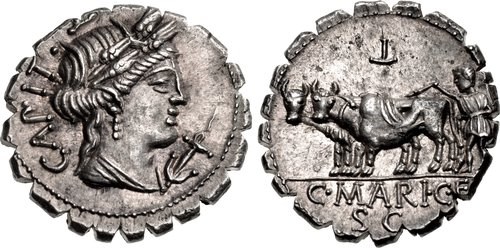
Also attributed to 81 BCE is this serratus of the moneyer C. Marius C.f. Capito, shown above. The obverse depicts the goddess Ceres and the reverse shows a man plowing with a yoke of oxen.
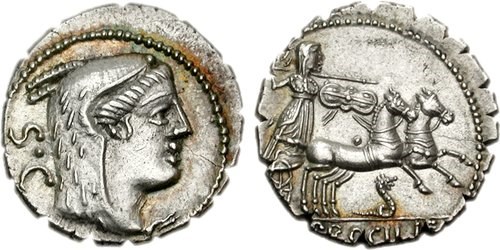
The moneyer L. Procilius struck the serratus above in c.80 BCE. It features the head of Juno Sospita and shows that same goddess holding a spear and a shield as she drives a biga.
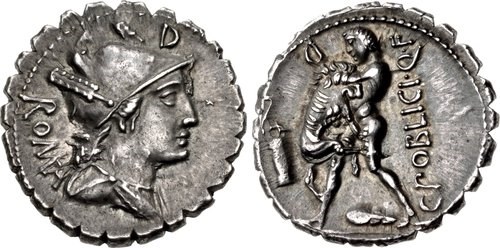
Another serratus from c.80 BCE, illustrated above, is of the moneyer C. Poblicius Q.f. It shows the bust of the state goddess Roma and a vigorous scene in which Hercules strangles the Nemean lion.
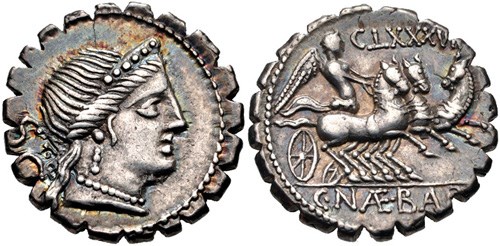

In c.79 BCE the moneyer C. Naevius Balbus had the serratus (above, top) struck at the Rome mint. It shows the head of the goddess Venus and portrays the goddess Victory driving a triga (a three-horse chariot). Shown beneath it is an imitative denarius of that issue, struck perhaps not long after the originals of this type had entered circulation. Like the issue it copies, the imitation also has a serrated edge.

Also from c.79 BCE is the serratus above, issued by the moneyer Ti. Claudius Ti.f. Ap.n. Nero. It shows the bust of the goddess Diana and a fast-moving biga driven by the goddess Victory.
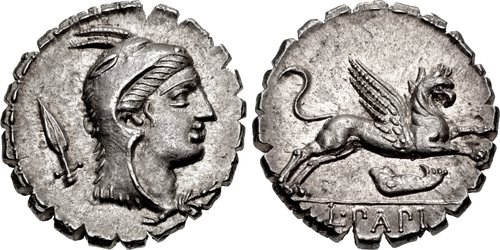
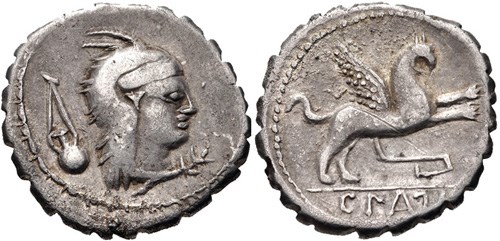
A third type of serratus issued in c.79 BCE – this one for the moneyer L. Papius – is shown above. It features the head of the goddess Juno Sospita and a leaping griffin. Shown beneath it is an imitative denarius, which also has a serrated edge.

A rarity among Republican serrati is the above denarius of the moneyer Q. Creperius M.f. Rocus, issued c.69 BCE. Its designs are especially attractive, showing the bust of the sea-goddess Amphitrite and the standing figure of her husband, the sea-god Neptune, who pilots a chariot drawn by two fanciful hippocamps.
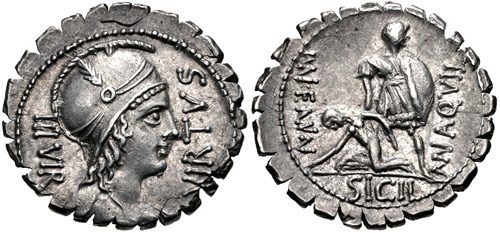
In c.71 or c.65 BCE the serratus of the moneyer Mn. Aquillius Mn.f. Mn.n., shown above, was issued at the Rome mint. It celebrates the heroic deeds of the moneyer’s ancestor, the consul Manlius Aquilius, in Sicily, by showing the bust of the personification Virtus and the consul raising the exhausted figure of Sicily.
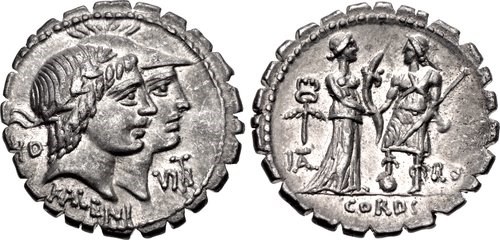
Another attractive serratus is the one above, issued in c.70 or c.68 BCE on behalf of the moneyers Q. Fufius Calenus and Mucius Cordus. It bears the heads of the personifications Honos and Virtus, and shows Italia and Roma clasping hands. The types allude to the end of hostilities in the ‘Social War’ (91-88 BCE) that pitted so many native inhabitants of the Italian peninsula against the might of Rome.
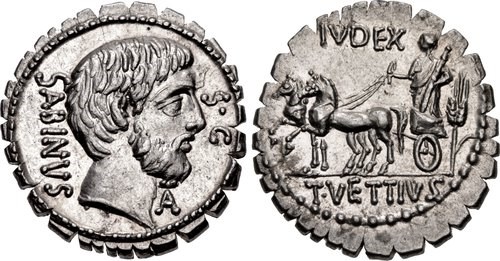
The moneyer T. Vettius Sabinus issued the serratus illustrated above in c.70 or c.66 BCE. It shows the head of Titus Tatius, a Sabine king from the mythical days of early Roman history, and a togate figure in a slow-moving biga. The type relates to the moneyer’s family, which claimed Sabine ancestry.

A bust of the goddess Diana and an energetic scene in which the Calydonian boar, transfixed with a spear, is attacked by a dog, appear on the serratus (above) issued by the moneyer C. Hosidius C.f. Geta in c.68 or c.64 BCE.
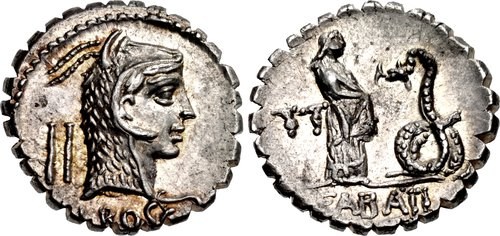
The last serratus issue, shown above, was produced for the moneyer L. Roscius Fabatus in c.64 or c.59 BCE. It shows the head of the goddess Juno Sospita and an uncertain standing female, who feeds a coiled serpent.
Images courtesy of Classical Numismatic Group (CNG).




